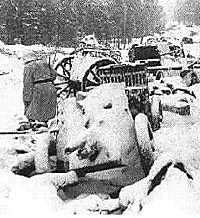
While the military situation on the northern front remained almost completely static during 1943, this year would prove to be a busy one on the diplomatic front. On 18 January the Red Army succeeded in opening a land route to Leningrad, and two weeks later the German 6 Army surrendered in Stalingrad. It now seemed to President Ryti that Finland had ultimately backed the wrong horse in this race (not that there had been much choice), and that it was time to seek an honorable way to exit the war as independently as she had entered it.
Russia made two separate but very severe peace offers to Finland in 1943, something it did not do for Romania or Hungary. Alexandra Kollontai, the USSR's ambassador to Sweden, made it clear to the Finnish representatives when she met with them to discuss the offers that the doctrine of unconditional surrender did not apply to Finland, nor would the USSR abrogate Finland's independence or force basic changes in its political system. However, the terms were very harsh and the Germans were still able to bring considerable pressure to bear on Finland, so Finland refused them. At the Teheran Conference in December 1943, Stalin told Roosevelt and Churchill that the two principal conditions of any peace offer to Finland would be the boundaries of 1940 (i.e., restoring what Russia had seized during the Winter War) and a war damage indemnity of $600 million.
More Finland Continuation War 1941-45
- Introduction
1941: Co-Belligerence in the North
1941: The Karelian Army Advances
1942: Motion Is Not Progress
1943: The Turn of an Unfriendly Card
1944 - The End of the Continuation War
Conclusion
Expatriate Soldiers
Mannerheim: Marshal of Finland
Finland: Jumbo Map of Operations
Back to Cry Havoc #30 Table of Contents
Back to Cry Havoc List of Issues
Back to MagWeb Master Magazine List
© Copyright 2000 by David W. Tschanz.
This article appears in MagWeb (Magazine Web) on the Internet World Wide Web. Other military history articles and gaming articles are available at http://www.magweb.com